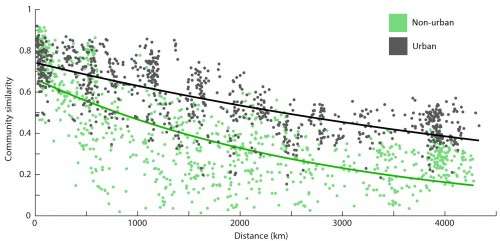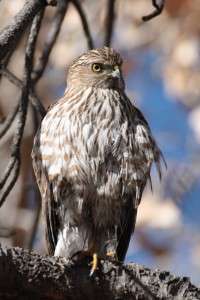Citizen science reveals large-scale effects of cities on bird diversity

In any city, several common characteristics catch the eye: high-rise buildings, endless pavement, and expansive human infrastructure like bridges and billboards. But cities are also home to green spaces such as large urban parks, gardens and golf courses. These matrices of urban habitats provide a wealth of resources that may benefit non-human city dwellers.
For birds, cities provide stable sources of food throughout the winter, such as cultivated plants, backyard feeders, and even trash. In addition, slightly warmer temperatures in cities generate ice-free water zones, an important resource for waterbirds. This prompted two graduate students and I at the University of New Mexico to ask, which species thrive in urban environments, and how does this affect the diversity of wintering birds across North America? Traversing the continent conducting extensive bird surveys—although tempting—was just not possible for a student project. So, to answer this question we turned to citizen science.
Each winter thousands of volunteers participate in the Christmas Bird Count, an annual census of winter birds administered by the Audubon Society. The survey is conducted in over 2,000 locations throughout much of the US and Canada, and is expanding to several Latin American, Caribbean and Pacific countries. This year alone, more than 55 million individual birds were counted! Such a colossal task could not be accomplished without the tens of thousands of committed citizen scientists who offer their time, enthusiasm, and local natural history expertise. They collect valuable information, allowing scientists to answer macroecological questions that cannot be addressed through traditional experiments or localized field studies.
To answer our questions, we combined survey data from the Christmas Bird Count (CBC) with land cover data from NASA satellite imagery. We then compared how species richness (the number of bird species at a location) and species turnover (how bird communities change across space) differ between urban and non-urban CBC sites.
The number of species found in urban and non-urban sites did not differ. However, the kinds of species present in each mattered. We found that urban sites had lower turnover of species than non-urban sites, meaning that bird communities were more similar to each other from one urban area to the next than between more natural, non-urban survey sites.
This is apparent when comparing the similarity of species between two survey locations to the distance between those locations (with a value of 1 meaning that the two locations share the exact same species and a value of 0 representing locations with completely different species). When comparing each individual survey location to all other survey locations, a distinct trend emerges. This type of comparison is called 'distance decay' and we found that the relationship to be very different when comparing non-urban (green) to urban (black) locations.

Urban bird communities tended to change more slowly across space than bird communities in non-urban areas. This means that two cities on opposite coasts of the US, such as Portland, Oregon and Portland, Maine (~4,000 km apart as the crow flies) will have more species in common than two relatively natural areas separated by the same distance.
This is due to two reasons. First, we found that abundances of birds were more similar across cities than across non-urban sites. This supports our idea that cities provide a stable influx of resources, such as food and water, regardless of differences in temperature and precipitation in surrounding natural areas. Similar and stable resources should support similar numbers of birds, regardless of location.
Second, cities share similar landscape features. For example, the city of Phoenix, with its parks and golf courses, is much more similar to Houston than the Sonoran Desert is to the subtropical forests and swamps outside of Houston. These similar urban habitats will support similar kinds of species, encouraging the establishment of species that are well suited to life around humans, including many non-native species, while reducing the presence of certain native species such as desert-adapted birds that cannot thrive in the desert oasis of Phoenix. Indeed, we saw that species found in urban areas tended to be more widespread – native and non-native – than species found in non-urban CBC survey sites.
Many people familiar with city birds may suspect that these patterns are driven by some of the more conspicuous non-native urban species (e.g., pigeons). We did in fact find that many non-natives were among the species that were present throughout all urban CBC sites (European Starlings, House Sparrows and Rock Pigeons), alongside several native generalists (Dark-eyed Juncos, Ring-billed Gulls and Canada Geese). The species which occurred more often in cities than in the non-urban sites tended to be aquatic species such as the American Coot, Wood Duck, Northern Shoveler and American Wigeon. (Check out Tables 1 and 2 in our paper to see a list of the most widespread species.) It's actually not so surprising that waterbirds were widespread, considering that cities are generally located near natural and artificial water bodies, providing suitable ice-free habitats for these birds year-round.
However, many of these non-native species were also quite common in the CBC's non-urban sites, indicating that human impacts extend far into adjacent natural landscapes. How humans facilitate the distributions of non-native species is an interesting avenue for future research.
Our study adds to the body of scientific evidence showing cities homogenize the diversity of birds and other various groups of plants and animals (e.g. McKinney 2006, Devictor et al., 2008 and Deguines et al., 2016). But thanks to the invaluable contributions of thousands of citizen scientists, we were able to tease apart the processes and identify the kinds of species that contribute to this homogenization.
More information: Adeline C. Murthy et al. Homogenizing effects of cities on North American winter bird diversity, Ecosphere (2016). DOI: 10.1002/ecs2.1216
Journal information: Ecosphere
Provided by Public Library of Science
This story is republished courtesy of PLOS Blogs: blogs.plos.org.




















